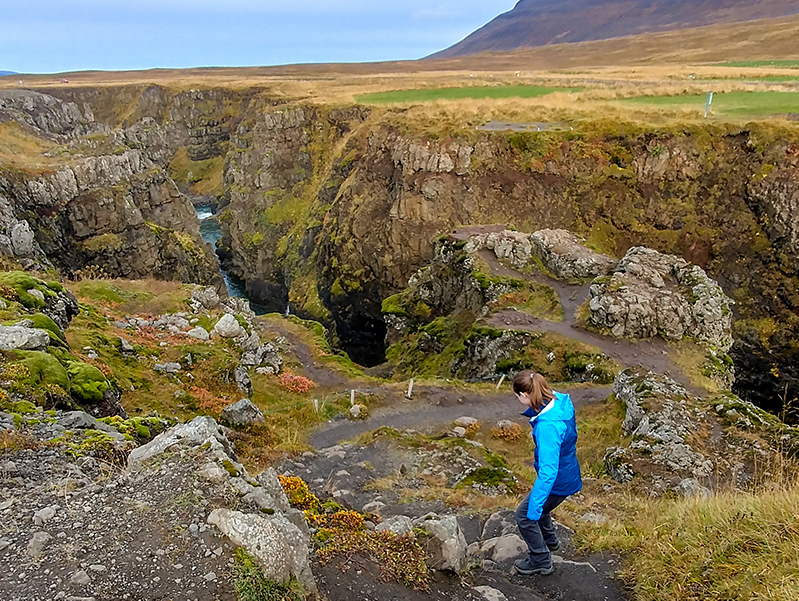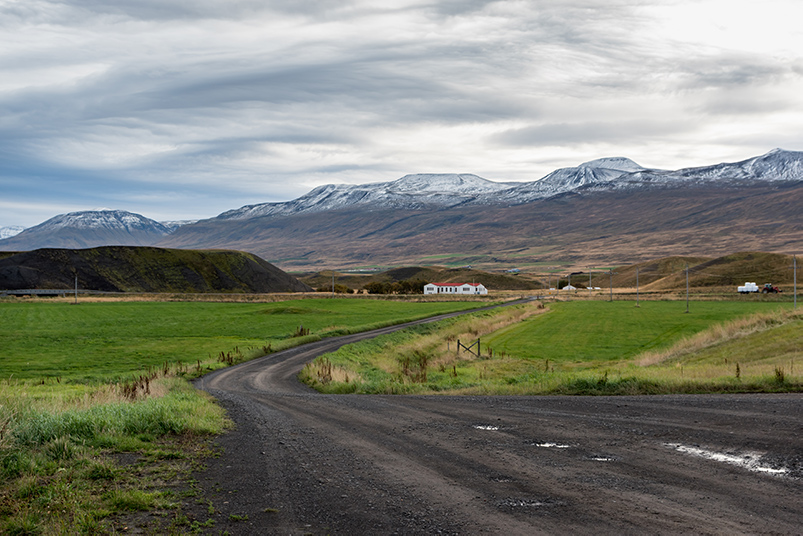10-06-17
Return to Iceland, Pt. 5
Vatnsnes to Sauðárkrókur
Our flatmates from Germany graciously and generously shared their breakfast with us: muesli, toast with butter and preserves, and coffee. They asked us about living in San Francisco. “Is it like Streets of San Francisco?” they wanted to know. That was the first time we’d heard of it – “you’re too young to know it,” they said. We pulled it up on YouTube and the soundtrack made me laugh. So 70’s! I told them the city really does still look similar today. They told us that Berlin has a lot of parks and it’s very common for people to bike everywhere.
We finished packing up and wished Silke and Verina the best on the rest of their trip. Their plans would take them up the western Vatnsnes coast for seal watching. As for us, we decided to visit the Seal Center by the harbor instead. There, we learned about the different types of seals that can be found around Iceland and about ongoing research projects, including one studying the impacts of tourism on seal colonies.
Established in 2005, Selasetur Íslands promotes seal colony research and responsible wildlife tourism.
Seals appear in Icelandic, Scottish, Irish and Faroese folktales in which they become human when they come ashore and remove their skins. It’s also said that they are vessels for the souls of the drowned. The origins of these ideas are mostly conjecture, but I thought it interesting that one simple influence might be the human-like eyes that seals have.
I bought a postcard I liked – a photograph of a sheep fold (like a circular livestock corral) in winter – and then we were off to Hvítserkur on the eastern side of the peninsula. We reached the iconic sea stack after 30 kilometers on rough dirt roads. Hvítserkur is an ancient volcanic plug that has been eroded by the sea; in fact it would have collapsed by now if not for human intervention. The base was reinforced with concrete some years ago.
There were quite a few tourists around despite the remote location. A steep path led down to the beach, and I considered taking it, as I would have loved to get closer and take some long exposures with the surf; but it looked muddy and precarious. I decided it wasn’t worth the risk. We still had quite a few days left in our trip, and I wanted to enjoy them without damaging myself or my camera!

We negotiated another 17 km of potholes to Borgarviki. Though there is no historical mention of it being used as such, the site – also a volcanic plug – is thought to have been a viking fortress, and commands impressive views of the local area. We had Borgarviki entirely to ourselves. As the wind whipped around us, I imagined what it might feel like to stand here watching hostile warriors approach. We scrambled up the loose stones where we found a column with a beautifully made view dial (a chrome plate with place names and distances to landmarks of the region). These plates are called “hringsjá” and can be found atop viewpoints around the country.


The dirt tracks eventually spit us out on the comparatively luxurious Ring Road, where we took another turn into the countryside toward Kolugljúfur. This canyon is named for the giantess Kola, whose daily activities are said to have carved out the gorge. The waterfall there was spectacular and we had largely unrestricted access (sticking to the paths, of course). This is my favorite aspect of Iceland – the ability to drive into the country and get up close to the fantastic landscape. Kolugljúfur was our top stop of the day and we took our time enjoying it in the warm afternoon light.


We had lunch nearby at the North West Hotel where we ordered lamb stew, bread and butter, and Appelsín. Our last stop in the area was a detour into Vatnsdal in search of one of the “innumerables” of Iceland, Vatnsdalsholar, a series of grass-covered mounds formed by a massive landslide. This area is the setting of Vatnsdœla Saga, which I’d just finished reading. A family chronicle spanning generations, it focuses largely on the exploits of three brothers as they settle disputes and fight black magic.


Rather than continue on the Ring Road, we planned to take roads 74 and 744 across the Skagi peninsula. We fueled up in Blönduós. Road 744 felt very remote. There were almost no buildings to be seen and surprisingly few places to pull over, though we did find a spot about halfway through. The view of Sauðárkrókur as we rounded Tindastóll and came down out of the hills was magnificent.
We were a couple hours too early to check in at our next AirBnB. I’d hoped to burn some time at Minjahús, a cultural museum; but in what was becoming a trend, it was closed. We tried to see if there was a way down to the waterfront and ended up driving south instead.


I stopped at the first point-of-interest sign I saw – Reynistaður. A farm dog trotted out to greet us as we checked out the informational sign and the nearby church. The dog kept us company while we took in our surroundings. Reynistaður was once the seat of an earl, and operated as a catholic convent for about 250 years until the reformation. Though the current church matches the early twentieth century style, a church of some kind has been at Reynistaður since the thirteenth century.
We continued on until we reached Glaumbær. This church building with its corrugated iron siding was finished in 1926 after the previous wooden building was destroyed by storms. The adjoining museum was just closing for the day, so could only explore a short time. I really enjoyed the architecture, and of course, the turf roofs.
An Icelandic turf building can last up to a century.
Source: glaumbaer.is
Icelandic grass grows very thickly, strengthening the turf with a combination of roots and soil. The roof must be sloped at the correct angle. Too flat, water leaks through; too steep, and the turf cracks during spells of dry weather or drains too quickly. We peeked inside the turf houses. They were full of period artifacts. My favorite buildings were the two nineteenth-century houses Áshús and Gilsstofa, both of which were moved onto the premises from elsewhere in Skagafjörður.



We returned to Sauðárkrókur and reached the farm in Hegranes at check-in time. The owners’ dogs, Dingo and Luka, came out to say hello. I asked Katelyn to distract them while I pulled up to the house. We were warmly welcomed by Arndís and Johann. They built up their home here over the past 5 years, and while parts of it remained unfinished, it seemed to me like a great deal of progress for such a short time. After settling in, we went into the main room to visit for a bit. Luka sidled up next to me for some quality ear scratching.
Arndís offered some suggestions for dinner in town and we opted for the Hard Wok Cafe. I couldn’t resist the silly name, and besides, stir-fry sounded good. The restaurant was cozy and had a lot of unexpected options, including Mexican food.
A quote by Blaise Pascal hung on the wall next to our table: “Truth is so obscure in these times, and falsehood so established, that, unless we love the truth, we cannot know it.” I don’t think I’ve ever found a quote from a 17th century philosopher so sobering and encouraging at the same time. Sobering because I guess some things haven’t changed since the 17th century; encouraging because the wisdom of the quote can still guide us.
When we returned, we decided to take advantage of the washer and dryer, so we could stop hauling around dirty clothes. Doing laundry in a foreign country seems so mundane – who wants to do chores on vacation? – but it was nice to have everything clean. Plus, we were able to pack a little bit lighter knowing we’d have the opportunity. We had a little trouble figuring out what settings to use – iconography only gets you so far when everything is in a different language – luckily, Arndís took a break from the Iceland v. Turkey football match to come to our rescue. The rest of the evening went by uneventfully.